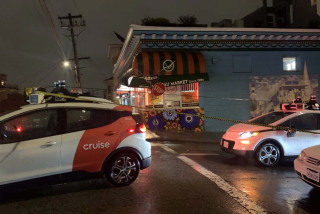New Crash Tests Rate Cars at Higher Speed
DETROIT â The Chevrolet Lumina, Ford Taurus and Volvo 850 top a safety groupâs new rankings of how well mid-size cars protect occupants from injuries in a 40-m.p.h. collision.
The three 1995 models were the only vehicles to receive an overall evaluation of âgoodâ in the Insurance Institute for Highway Safetyâs first test of its kind. The organization examined only mid-size cars but said it plans to test larger and smaller models in the future.
The 14 mid-size 1995 models tested and their âtwinâ models--a Mercury Sable for the Ford Taurus, for instance--represent about a quarter of the new models sold in the United States.
The Toyota Camry, Subaru Legacy, Honda Accord and Mazda Millenia were judged acceptable by the institute, while the Saab 900 was rated marginal. Rated poor were the Ford Contour, Volkswagen Passat, Chevrolet Cavalier, Mitsubishi Galant, Chrysler Cirrus and Nissan Maxima.
The federal government requires that all new cars meet standards for head and chest protection in crash tests into a solid barrier at 30 m.p.h.
The National Highway Traffic Safety Administration tests cars in 35-m.p.h. crashes and rates them as a guide for consumers.
The insurance industry-backed instituteâs tests are designed to complement the government testing and give car buyers an additional tool to use in judging the safety of vehicles they consider buying, President Brian OâNeill said.
âWe believe that the governmentâs new-car assessment program has been one of the most powerful stimuli to the manufacturers over the years to improve the designs of their cars, especially their restraint systems,â he said.
The government program has been around long enough so that most passenger cars it tests meet federal safety standards for 30-m.p.h. crashes and the higher test speed of 35 m.p.h. That makes information from the tests less useful for comparison shopping, OâNeill said.
The insurance institute tests used an âoffsetâ collision in which the car was slammed into a barrier that came in contact with only one side of the front of the car. The barrier is made of a honeycomb material that gives when the car slams into it, like another vehicle might. The test is similar to those being developed in Europe, and it tries to measure lower-body injuries to a greater extent than does the âfull-width,â fixed-barrier test.
Government tests involve head-on, full-width collisions into a solid, stationary barrier and primarily measure the ability of the car structure, seat belts and air bags to prevent life-threatening upper-body injuries.
Barry Felrice, NHTSA associate administrator for safety performance standards, said the agency has asked Congress for money to expand its crash test program to include side collisions, which it considers a higher priority than offset tests.
Auto manufacturers acknowledged that offset crash testing is useful, but Ford Motor Co. criticized the instituteâs results, saying they are not indicative of real accidents
(BEGIN TEXT OF INFOBOX / INFOGRAPHIC)
Crash Ratings
The Insurance Institute for Highway Safetyâs simulated car smashups try to gauge lower-body injuries to a greater extent than to do the fededral government tests. Overall evaluations* of mid-size four-door cars:
Car and Rating: Chevrolet Lumina--Good Ford Taurus--Good Volvo 850--Good Toyota Camny--Acceptable Subaru Legacy--Acceptable Honda Accord--Acceptable Mazda Millenia--Acceptable Saab 900--Marginal Ford Contour--Poor Volkswagen Passat--Poor Chevrolet Cavalier--Poor Mitsubishi Galant--Poor Chrysler Cirrus--Poor Nissan Maxima--Poor
Cars were rated as Good, Acceptable, Marginal or Poor based on structure, driver, restraints, the movement of a test dummy during the collision, the injuries to various body parts and the performance of head retraints and bumpers.
* Source: Associated Press






